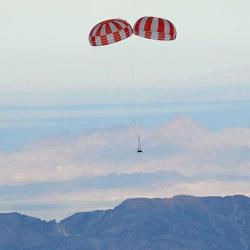Source Institutions
Add to list Go to activity
Activity link broken? See if it's at the internet archive

Learners investigate how drag affects the falling rate of objects. They construct paper objects of different shapes and sizes, use clay to make them all the same mass, and then drop them all from the same height. In this way, learners can see how cross-sectional area can affect drag and therefore falling speed. In further experiments, learners can test objects of the same size and shape but different masses to see how drag is affected. This activity gives learners a great opportunity to discuss experimental design as there are multiple variables to investigate or control. Resource has suggestions for assessment and extensions.
- Under 5 minutes
- 45 to 60 minutes
- 1 cent - $1 per group of students
- Ages 11 - 14
- Activity, Experiment/Lab Activity, Lesson/Lesson Plan
- English
Quick Guide
Materials List (per group of students)
- Modeling clay, washers or pennies
- Cellophane or masking tape
- 1 pair of scissors
- 1 copy of Drag Shapes Handout
- 4 copies of What a Drag! Worksheet
- 1 stopwatch or a watch with a second hand
- 1 balance (or take turns if not enough are available)
Subjects
-
Earth and Space Science
-
Earth Structure
- Atmosphere
-
Earth Structure
-
Mathematics
-
Data Analysis and Probability
- Data Analysis
- Data Collection
-
Geometry
- Solid Geometry
-
Measurement
- Units of Measurement
- Rate
-
Data Analysis and Probability
-
Physical Sciences
-
Motion and Forces
- Gravity
- Momentum and Velocity
- Newton's Laws
- Center of Gravity
-
States of Matter
- Gases
-
Motion and Forces
-
The Nature of Science
-
The Scientific Process
- About Inquiry
- Asking Questions
- Conducting Investigations
- Gathering Data
- Formulating Explanations
-
The Scientific Process
Audience
To use this activity, learners need to:
- see
- touch
Learning styles supported:
- Involves hands-on or lab activities
Other
Includes alignment to state and/or national standards:
This resource is part of:
Access Rights:
- Free access
By:
- Rutkowski, Tom ; Conner, Alex ; Hill, Geoffrey ; Schaefer Zarske, Malinda ; Yowell, Janet
Source Collection
- TeachEngineering
Rights:
- All rights reserved, Regents of the University of Colorado, 2004
Funding Sources:
- National Science Foundation, 0226322
- Fund for the Improvement of Postsecondary Education (FIPSE)
- U.S. Department of Education
